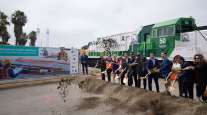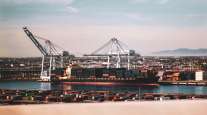Ports of Los Angeles and Long Beach Escalate Clean Air Plan

Los Angeles and Long Beach, the two largest ports in North America, also propose expanding programs that reduce ship emissions.
Other proposals focus on freight infrastructure investment, innovation and technology to improve supply chain efficiency and comprehensive energy planning. The plan also seeks increased advocacy for stricter emissions standards and government incentives to help pay for projects that advance testing and commercialization of zero and near-zero emissions vehicles.
The updated CAAP provides one of California’s first opportunities to implement the vision laid out in the state’s Sustainable Freight Action Plan.
The proposal would phase in clean engine standards for port trucks and offer preferential terminal access to green trucks, with a goal of transitioning to a zero-emissions drayage fleet by 2035. It also would reduce idling and transition to zero-emissions yard equipment by 2030.
Ports officials met Nov. 17 to mark the 10th anniversary of the initiative and unveil the CAAP 2017 Discussion Document, which outlines new concepts under consideration for the third iteration of the CAAP.
“The ports of Los Angeles and Long Beach are driving forces of our region’s economy — they should also be models for how we move toward a more sustainable future by balancing growth and environmental stewardship,” said Los Angeles Mayor Eric Garcetti. “The draft Clean Air Action Plan is an important step in our work to reduce air pollution in our communities, and take action on climate change. I look forward to working with [Long Beach] Mayor [Robert] Garcia to build on this progress and continue strengthening this plan in the coming months.”
“These updates will move the region closer to a zero-emissions future," Garcia said. “We have already proven that it’s possible to increase jobs and trade with cleaner air and healthier communities, and I want to thank all of our partners who helped make this possible.”
The Discussion Document prioritizes reducing greenhouse-gas emissions from port-related sources 80% below 1990 levels by 2050. The target aligns with California’s clean air goals and objectives in the state’s new Sustainable Freight Action Plan, as well as efforts by the cities of Los Angeles and Long Beach to shrink GHG emissions ahead of state targets. Cutting GHG emissions also helps the ports maintain and increase their dramatic progress in reducing other key pollutants, namely diesel particulate matter, nitrogen oxides and sulfur oxides.
The joint meeting kicked off a three-month public review and comment period that extends through Feb. 17, 2017. The ports plan to incorporate public comments received and present the 2017 CAAP Update for final consideration by their governing boards in spring 2017 at another joint harbor commission meeting.
CAAP 2017 improves upon the initial plan adopted in 2006 and updated in 2010 to reduce emissions from all port-related sources: ships, trucks, trains, cargo-handling and smaller harbor craft, such as tugboats.
Under the CAAP, the ports of Los Angeles and Long Beach say they have reduced DPM up to 85%, cut NOx in half, eliminated 97% of SOx, and lowered GHG an average of 12%, all while container volume has increased by 7%.
The two ports handle about 40% of the nation’s total containerized import traffic and 25% of its total exports.




